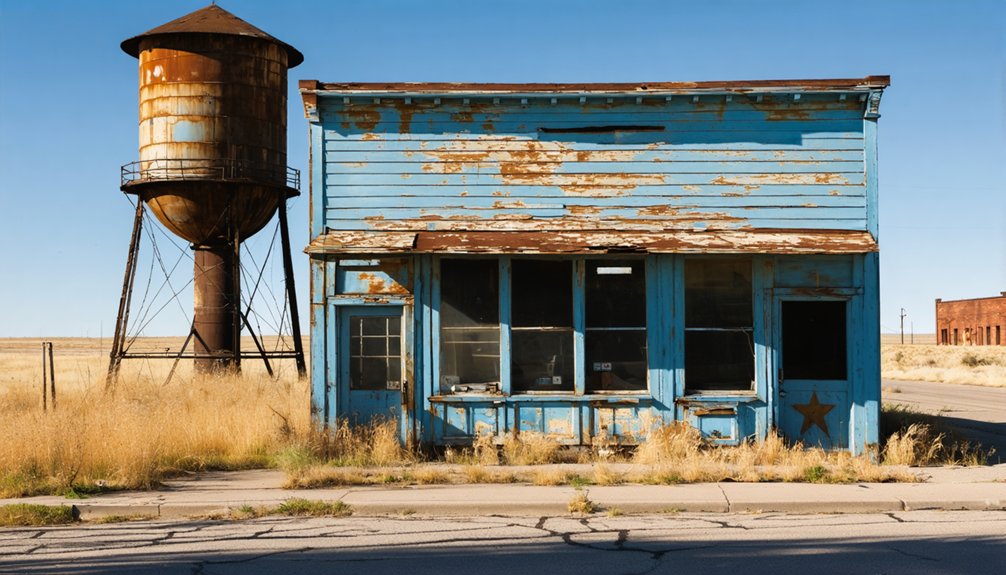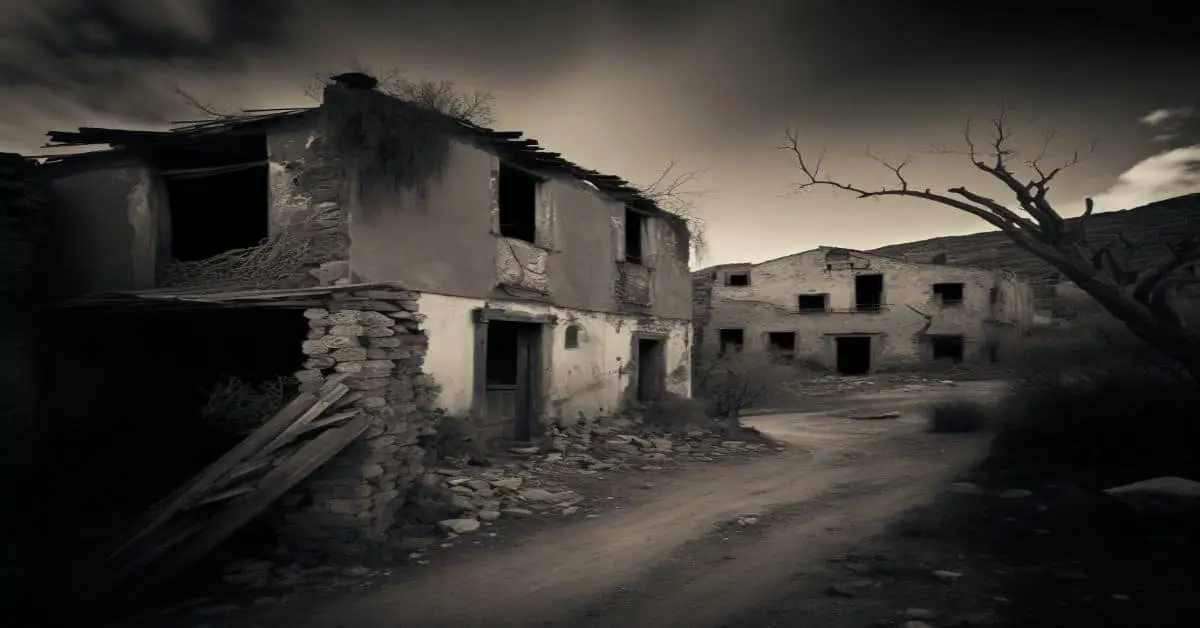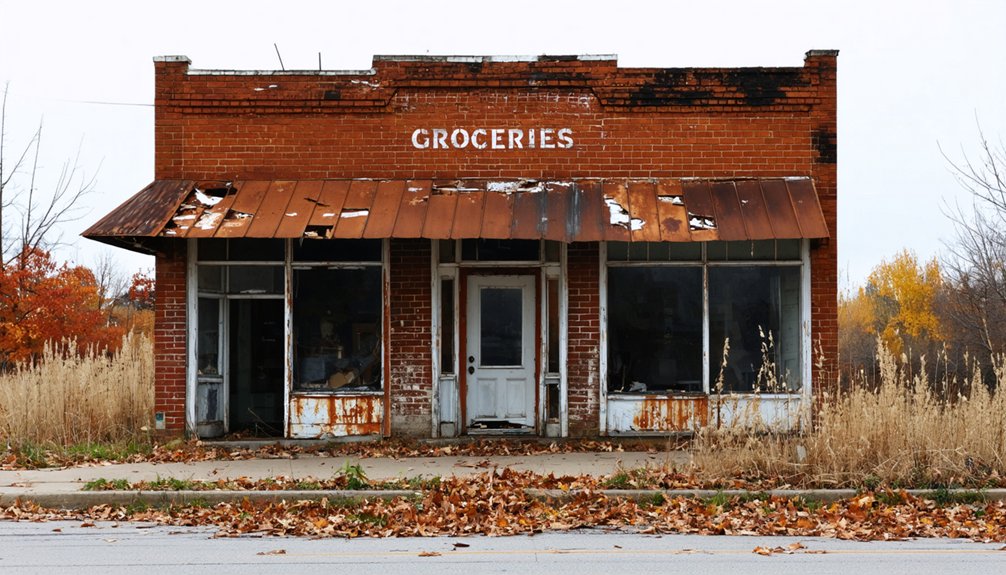You’ll discover Shady Grove’s ghost town remnants at the intersection of County roads D47 and V65 in Buchanan County, Iowa. This former mining community, established in 1857, once boasted eight active coal mines, a machinery dealership, creamery, and general store. The town peaked at 29 residents in 1925 before declining through the decades. Today, only scattered traces remain, including the historic cemetery and relocated general store, each holding untold stories of Iowa’s pioneering spirit.
Key Takeaways
- Founded in 1857 in Buchanan County, Iowa, Shady Grove was a self-sustaining frontier community at the intersection of County roads D47 and V65.
- The town featured eight active coal mines, a machinery dealership, creamery, general store, and church during its peak economic period.
- Population peaked at 29 residents in 1925 but declined steadily, with the post office closing and last general store shuttering in the 1980s.
- Today, most of Shady Grove has been replaced by agricultural fields and suburban homes, with only a few historical structures remaining.
- The relocated general store building and remnants of a machine shed with “Shady Grove” signage survived into the 1990s as historical markers.
A Hidden Past Unearthed: Origins of Shady Grove
Nestled between the towns of Jesup and Brandon in Buchanan County, Iowa, Shady Grove emerged as a small settlement in 1857 at the intersection of what we now know as County roads D47 and V65.
In 1857, Shady Grove took root in Buchanan County, Iowa, marking its place at the crossroads of rural America.
You’ll find this early settlement’s history etched into the western edge of Jefferson Township, where ambitious pioneers established a self-sustaining community with all the essentials of frontier life.
Like many small farming communities, economic decline gradually impacted local businesses as larger towns drew residents away for shopping and services.
As you explore Shady Grove’s past, you’ll discover how the community dynamics revolved around essential establishments – a bustling post office, a machine dealership, a general store, and a creamery that served local farmers.
The town’s spiritual and educational needs weren’t forgotten either, with both a church and school anchoring the community, reminiscent of the way the Grotto of the Redemption served as a spiritual cornerstone for West Bend.
While the settlement showed promise, you’d be surprised to learn that by 1958, only 25 residents called Shady Grove home.
Life in a Bustling Mining Town
If you’d visited Shady Grove during its heyday, you’d have found a vibrant community built around eight active coal mines, with the Climax Coal Company leading the local industry.
You could have shopped at the general store, dropped off milk at the creamery, or attended services at the local church – all essential parts of daily life that kept the close-knit community connected.
While miners toiled underground, the town’s businesses, including a machine dealership and post office, served the practical needs of residents and created gathering spaces where neighbors formed lasting bonds. Established in County roads junction where D47 and V65 meet, the town became a strategic transportation hub for the region. The diverse community included many European immigrant workers who came seeking mining jobs and brought their cultural traditions with them.
Daily Mining Operations
While Iowa’s coal mines hummed with activity day and night, Shady Grove’s operations exemplified the typical mining town’s intense daily routine.
You’d find hundreds of workers descending into the depths across two daily shifts, each miner assigned to specific “places” where they’d extract coal using picks, bars, and hammers. These weren’t casual operations – every strike had to be precise, every ear trained to detect unstable seams through sound. Like today’s modern security systems, the miners relied on ongoing safety protocols to protect their daily operations.
You’d witness a carefully orchestrated system where miners transported their tools to work sites, methodically chipped away at coal faces, and loaded mine cars for transport. Mining ponies remained underground during the winter months to help haul the coal through the tunnels.
Steam hoists lifted both miners and coal from depths reaching 171 feet, while superintendents coordinated the complex dance of shift schedules, ventilation maintenance, and production goals.
Community Social Life
Beyond the mines’ clamor and daily grind, Shady Grove pulsed with vibrant community life centered around its church, school, and local businesses. You’d find residents gathering at the general store and creamery, sharing news and strengthening bonds that held their small town together.
The social structures revolved around weekly church services, school events, and community gatherings that brought together the town’s diverse population, including a successful Black community during the mining era. The town’s commitment to accessibility meant they avoided JavaScript requirements that could exclude any residents from participating in community events. The town’s security measures prioritized seamless interaction between all community members during social gatherings.
Though the town never grew large – peaking at just 25 residents by 1958 – you’d witness a tight-knit community where miners, families, and business operators supported one another through daily life.
Local celebrations, holiday observances, and informal socializing at work breaks wove the fabric of this close-knit mining town‘s identity.
Business and Commerce
Unlike many Iowa ghost towns that relied heavily on mining, Shady Grove’s commercial heart beat through its diverse collection of small businesses at the junction of County roads D47 and V65.
You’d have found all your essential needs met at the general store, while the local creamery supplied fresh dairy products to the community. The machine dealership demonstrated business resilience by serving the agricultural needs of the surrounding farms.
The town’s economic adaptation was evident in how its businesses complemented each other, with the post office facilitating communication and trade.
Though the population dwindled to about 25 people by 1958, these enterprises had served their community well since the town’s establishment in 1857, creating a self-sufficient hub for local commerce.
Economic Rise and Fall Through the Decades
You’ll find Shady Grove’s early economy in 1857 featured a diverse mix of businesses, including a machinery dealership, creamery, general store, and church that served local farmers and residents.
While the town never became a mining center, its agricultural focus and retail offerings helped maintain a modest population that peaked at 29 residents by 1925. The town required careful disambiguation of places due to several other locations sharing the Shady Grove name across America.
Like the abandoned post office of Altamount in Fairview, Shady Grove’s fortunes gradually declined through the mid-20th century, culminating in the closure of its last general store in the 1980s and leaving only scattered remnants of its once-bustling commercial life.
Mining Drives Town Growth
The economic fortunes of Shady Grove followed a different trajectory than Iowa’s prominent mining towns of the era. While nearby coal camps in Boone County employed hundreds and built extensive infrastructure, Shady Grove’s mining impact remained indirect.
You’ll find no evidence of active mines within the town itself, though the regional coal industry’s influence touched every aspect of local life.
Unlike bustling mining communities with their company stores and worker housing, Shady Grove maintained a modest economic profile. The town’s peak population of just 29 residents in 1925 reflects its limited economic dependency on coal operations.
Instead of the boom-and-bust cycle typical of Iowa’s mining towns, you’ll see that Shady Grove experienced a gradual decline, driven more by broader rural migration patterns than the collapse of coal mining.
Diverse Business Hub Emerges
Despite its modest size, Shady Grove blossomed into a vibrant business center following its 1857 founding at Jefferson Township’s western edge. You’d find remarkable business diversity in this unincorporated settlement, where a bustling machinery dealership operated alongside a productive creamery and well-stocked general store.
The community’s economic resilience became evident as it grew to support nearly 100 residents at its peak. When the post office opened in 1886, it served as another essential hub for the town’s commercial activities.
The surrounding farmland sustained the local economy, while the general store acted as the heart of daily commerce. Though small, Shady Grove’s mix of agricultural and retail enterprises created a self-sufficient community where neighbors relied on each other’s services and skills.
Decline After Mine Closures
Contrary to what its name might suggest, Shady Grove’s decline wasn’t triggered by mine closures but rather by a gradual rural exodus that began in the early 1900s.
Unlike towns affected by mining impact, Shady Grove’s community changes stemmed from broader demographic shifts as younger residents sought opportunities elsewhere.
You can trace the town’s gradual transformation through these key developments:
- Population dropped to just 12 residents by 1902
- Only 29 residents remained by 1925
- Seven families (25 people) called Shady Grove home in 1958
- The general store, the town’s last business stronghold, closed in the 1980s
Without a railroad connection or major industry to sustain it, Shady Grove’s fate mirrored countless other rural Iowa communities, slowly fading as agricultural consolidation reshaped the landscape.
The African American Mining Community
While Shady Grove itself wasn’t mainly an African American mining settlement, nearby coal mining communities like Buxton exemplified the rich cultural tapestry of Iowa’s mining history.
You’ll find stories of African American resilience in towns where Black miners worked alongside European immigrants, creating vibrant communities that defied the era’s racial norms.
In places like Buxton, you’d have discovered a thriving African American population exceeding 5,000 residents at its peak. Their cultural heritage flourished through Black-owned businesses, churches, and schools.
Buxton’s vibrant African American community built a remarkable legacy through their thriving businesses, churches, and educational institutions.
These communities stood out for their integrated workplaces and public spaces, a remarkable achievement for the early 20th century. The Consolidated Coal Company’s progressive employment policies helped create an environment where African American workers and entrepreneurs could build prosperous lives for themselves and their families.
What Remains: A Modern-Day Glimpse
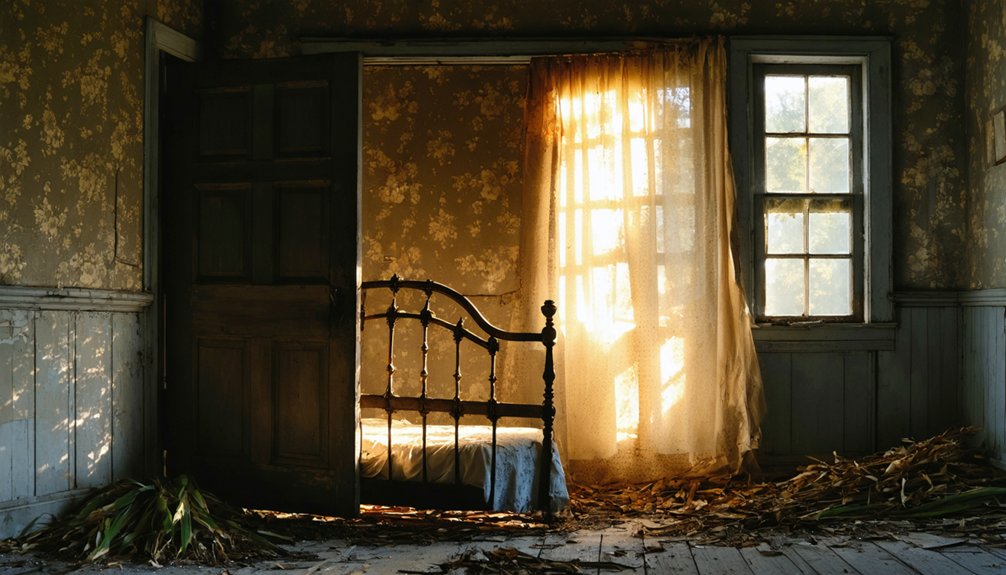
Today, you’ll find few traces of Shady Grove‘s once-bustling community, as most physical remnants have yielded to agricultural fields and modern development.
The once-thriving town has transformed into a mix of farmland and new suburban homes, with over forty houses built since the mid-1990s.
Among the remaining structures, you might discover:
- The old cemetery on former Youngblut land, now protected by the Buchanan County Historical Society
- A relocated general store building on Spring Creek Road, preserved from the 1980s
- The site where a barber shop stood until 2004, with historic newspaper-lined walls
- Scattered remnants of the large machine shed that displayed “Shady Grove” into the 1990s
The cemetery’s preservation stands as a poignant reminder of the community that once called this land home.
Historical Legacy and Cultural Impact
Since its establishment in 1857, Shady Grove has left an indelible mark on Buchanan County’s history as a quintessential Iowa pioneer settlement.
Shady Grove represents the enduring legacy of Iowa’s pioneering spirit, standing as a testament to frontier settlement since 1857.
You’ll find its cultural resilience reflected in the way it adapted through changing times, from its bustling early days with a post office, machine dealership, and creamery to its later transformation. The town’s historical significance stems from its role in Iowa’s development, where community life centered around the local church and school, creating strong social bonds among residents.
While the original settlement declined by 1958 to just 25 people, Shady Grove’s story didn’t end there.
In the early 2000s, you witnessed a remarkable revival as over 40 new homes sprang up, drawn by lower taxes and favorable zoning – proving that pioneer spirit lives on in modern times.
Lessons From a Lost Settlement
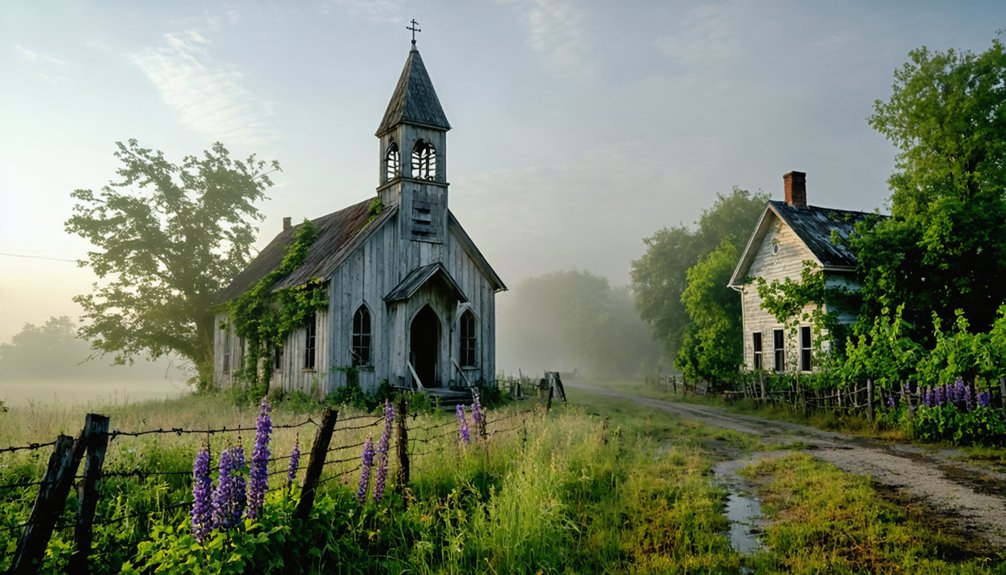
Through its rise and fall, Shady Grove offers compelling lessons about rural sustainability and economic resilience.
You’ll find that the town’s story mirrors many rural communities that faced similar abandonment causes: over-reliance on a single industry, lack of economic diversification, and isolation from major transportation routes.
The decline wasn’t sudden but rather a gradual exodus that followed the closure of coal mines in 1927.
- When businesses depend solely on one industry, they’re vulnerable to economic shocks
- Communities need to adapt to changing transportation and market patterns
- Environmental resource management plays an important role in long-term sustainability
- Infrastructure investment and modernization are essential for rural survival
Today’s rural communities can learn from Shady Grove’s experience by diversifying their economic base and staying connected to broader market networks.
Frequently Asked Questions
Were There Any Notable Crimes or Scandals in Shady Grove’s History?
You won’t find mysterious disappearances or scandalous local legends here – historical records show no major crimes or scandals occurred during the town’s existence before it became a ghost town.
What Was the Average Home Price in Shady Grove During Its Peak?
You’d likely find the average home costing between $300-$800 during peak mining years, though the historical market was informal with limited records and most properties tied to mining operations.
Did Any Famous People Ever Visit or Live in Shady Grove?
You won’t find any records of famous visitors or notable residents in this small town’s history. The community was made up entirely of everyday farmers, merchants, and local laborers.
How Did Residents Celebrate Holidays and Special Occasions in Shady Grove?
Paint the town red at local churches and stores where you’d join holiday traditions through potluck dinners, seasonal sales, hymn singing, and special gatherings with family and neighbors.
What Were the Most Common Causes of Death Recorded in the Cemetery?
You’d find infectious diseases dominated the cemetery records, with outbreaks of tuberculosis, smallpox, and typhoid fever claiming many lives. Farming accidents, harsh winters, and childhood illnesses also took their toll.
References
- https://freepages.history.rootsweb.com/~gtusa/usa/ia.htm
- https://kids.kiddle.co/List_of_ghost_towns_in_Iowa
- https://raregoldnuggets.com/?p=3950
- https://www.discoverguthriecounty.org/ghosttowns
- https://pubs.lib.uiowa.edu/annals-of-iowa/article/id/6960/download/pdf/
- https://en.wikipedia.org/wiki/List_of_ghost_towns_in_Iowa
- http://genealogytrails.com/iowa/buchanan/abandoned_towns_01.htm
- https://pubs.lib.uiowa.edu/annals-of-iowa/article/7045/galley/115796/view/
- http://www.iowapbs.org/article/8600/local-legends-around-iowas-haunted-locations
- https://www.youtube.com/watch?v=1J0Qx64ZrwI
